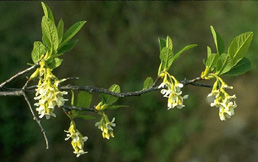Plant Data
Sheet: Indian

Range
Indian plum is found west of the Cascades. It ranges from coastal southern
Climate,
elevation
Indian plum is found at low
elevations (1). It prefers
the climate typical of the
Local
occurrence (where, how common)
Indian plum is common west of the Cascades. Due to a preference for open areas, it is
often found along roadsides and does well in disturbed areas (1).
Habitat
preferences
Indian plum prefers dry to moist, open woods. It is often found on stream banks and in open
areas, such as roadsides (1,7).
Plant
strategy type/successional stage (stress-tolerator, competitor,
weedy/colonizer, seral, late successional)
Indian
plum is a late seral, understory, forest shrub.
Associated
species
Indian plum is often found growing near elderberry
(Sambucus racemosa), red osier
dogwood (Cornus sericea), stinging nettle (Uritica dioica),
vanilla leaf
(Achlys triphylla), foamflower (Tiarella spp.) and salal (Gaultheria
shallon) (3).
May
be collected as: (seed, layered, divisions, etc.)
Seeds can be collected.
Hardwood cuttings are also successful. This plant produces numerous
suckers, which can be removed from the parent plant during the winter months
and will survive on their own in favorable conditions (3). Plants less
than 5’ also salvage well (7).
Collection
restrictions or guidelines
Due to its popularity with birds, seed should be collected
in June as soon as it ripens. It can
then be dried whole and sown in the fall (6). There are variable
results from hardwood cuttings. For best results, use vigorous 1-yr old wood
and take the cuttings early in winter prior to bud swell (4).
Seed
germination (needs dormancy breaking?)
Germination of spring-sown seed is more successful if the
seeds are cold stratified for four months (3,7). During this process, seed germination may
occur. The seeds should be monitored bi-weekly and sprouted seeds removed (7).
Seed
life (can be stored, short shelf-life, long shelf-life)
Seeds can be stored and should be cleaned before storage (7). Information on seed shelf- life is not
readily available.
Recommended
seed storage conditions
Information on recommended seed storage conditions is not
readily available.
Propagation
recommendations (plant seeds, vegetative parts, cuttings, etc.)
Propagation
from seed is successful. Vegetative
propagation from cuttings and suckers is moderately successful (4,7).
Soil
or medium requirements (inoculum necessary?)
Indian plum does not appear to have any specific soil or
inoculum requirements.
Installation
form (form, potential for successful outcomes, cost)
Indian plum can be installed
as container or bare root material.
Rooted suckers and seeds can also be used with success.
Recommended
planting density
4-6’
apart (2).
Care
requirements after installed (water weekly, water once etc.)
Although
indian plum is drought tolerant, periodic watering during establishment is
necessary. Deep watering may not be necessary due to its shallow, spreading
root growth (5).
Normal
rate of growth or spread; lifespan
Indian
plum has a short longevity (5).
It is fairly fast growing and may eventually may reach a height of 5-16’
(7).
Sources
cited
(1) Pojar, J. &
MacKinnon, A (eds.) (1994). Plants of the
(2) Riparian (Stream side)
vegetation, Public information handout number 31-D.
(3) Hansen, W. Native
Plants of the Northwest. http://www.nwplants.com. Retrieved
(4) Crowder, W.
& Darris, D. Producing
(5) King County
Department of Natural Resources. Role
and Use of Vegetation. http://dnr. metrokc.gov/wlr/biostabl/PDF/9305BnkStbCh6.pdf. Retrieved
(6) King County Department of Public Works (1994). Northwest Native Plants: Identification and Propagation for Revegetation and Restoration Projects.
(7) Leigh, M.
(1999). Grow Your Own Native
Landscape: A guide to identification,
propagation, and landscaping with western
Data
compiled by (student name and date)
Sarah Baker